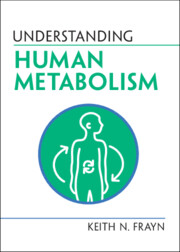Book contents
- Understanding Human Metabolism
- Series page
- Understanding Human Metabolism
- Copyright page
- Reviews
- Contents
- Foreword
- Preface
- Acknowledgements
- 1 What Is Metabolism?
- 2 Metabolic Fuels
- 3 Metabolic Pathways
- 4 Communication Systems in Human Metabolism
- 5 ATP: The Common Currency of Metabolic Energy
- 6 Metabolism in Daily Life
- 7 Metabolism Is So Adaptable
- 8 Metabolic Interactions between Nutrients
- 9 Metabolic Disorders
- Concluding Remarks: Human Metabolism in Context
- Summary of Common Misunderstandings
- References
- Figure Credits
- Index
Concluding Remarks: Human Metabolism in Context
Published online by Cambridge University Press: 25 August 2022
- Understanding Human Metabolism
- Series page
- Understanding Human Metabolism
- Copyright page
- Reviews
- Contents
- Foreword
- Preface
- Acknowledgements
- 1 What Is Metabolism?
- 2 Metabolic Fuels
- 3 Metabolic Pathways
- 4 Communication Systems in Human Metabolism
- 5 ATP: The Common Currency of Metabolic Energy
- 6 Metabolism in Daily Life
- 7 Metabolism Is So Adaptable
- 8 Metabolic Interactions between Nutrients
- 9 Metabolic Disorders
- Concluding Remarks: Human Metabolism in Context
- Summary of Common Misunderstandings
- References
- Figure Credits
- Index
Summary
Many years ago now, I spent three busy years studying biochemistry. After my first degree, I researched for three years for my PhD, studying a new treatment for diabetes called metformin – now an old drug, but still widely used, and a first line of treatment for many patients. (We still don’t really know how it works.) Then I worked for about half my career studying metabolic responses to trauma – of the physical kind, not the mental. This involved many studies of patients in hospital with injuries or following major operations. It was difficult work – nobody sets out to be injured and so there is no standardisation of feeding state, alcohol intake, time of day, or any of the other factors one would normally control in metabolic experiments; not even a standard form of injury. This research gave me a very clear view of the mechanisms that integrate human metabolism under stress. But it wasn’t until I moved to the University of Oxford, about the middle of my career, and started studying metabolism in healthier people, that I understood that our daily lives involve much more subtle changes in metabolic pathways, brought about less by the nervous system and much more by hormones, especially insulin.
- Type
- Chapter
- Information
- Understanding Human Metabolism , pp. 157 - 158Publisher: Cambridge University PressPrint publication year: 2022



